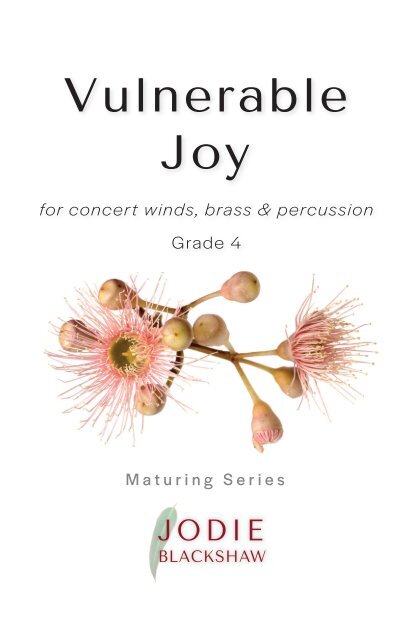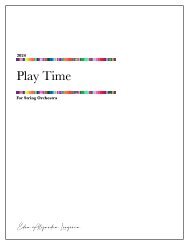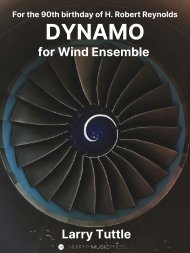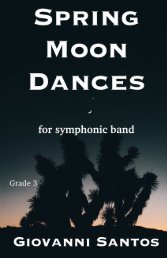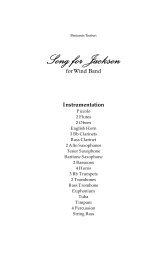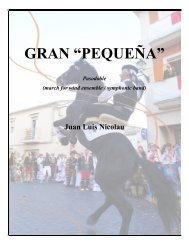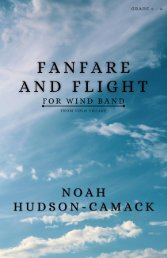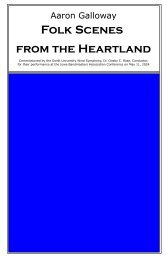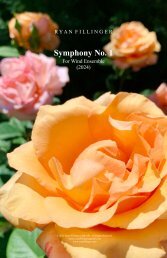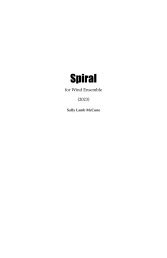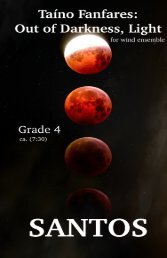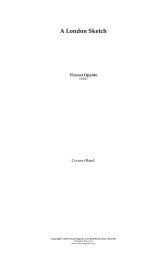Create successful ePaper yourself
Turn your PDF publications into a flip-book with our unique Google optimized e-Paper software.
<strong>Vulnerable</strong><br />
<strong>Joy</strong><br />
for concert winds, brass & percussion<br />
Grade 4<br />
Maturing Series<br />
JODIE<br />
BLACKSHAW
<strong>Vulnerable</strong> <strong>Joy</strong><br />
FOR WOODWIND, BRASS & PERCUSSION<br />
JODIE BLACKSHAW<br />
INSTRUMENTATION<br />
PICCOLO<br />
FLUTE I<br />
FLUTE II<br />
OBOE<br />
BASSOON I<br />
BASSOON II<br />
CONTRA BASSOON (OPT.)<br />
CLARINET I IN B ♭<br />
CLARINET II IN B ♭<br />
CLARINET III IN B ♭<br />
CLARINET IV IN B ♭<br />
BASS CLARINET IN B ♭<br />
CONTRABASS CLARINET IN B ♭ (OPT.)<br />
TRUMPET I IN B ♭<br />
TRUMPET II IN B ♭<br />
TRUMPET III IN B ♭<br />
1 ST HORN IN F<br />
2 ND HORN IN F<br />
3 RD HORN IN F<br />
4 TH HORN IN F<br />
TROMBONE I<br />
TROMBONE II<br />
BASS TROMBONE<br />
EUPHONIUM<br />
TUBA<br />
DOUBLE BASS<br />
ALTO SAXOPHONE I<br />
ALTO SAXOPHONE II TIMPANI (4)<br />
TENOR SAXOPHONE<br />
PERCUSSION (6) SEE BELOW<br />
BARITONE SAXOPHONE<br />
MALLET PERCUSSION I: MARIMBA, TRIANGLE, SUSPENDED CYMBAL<br />
MALLET PERCUSSION II: GLOCKENSPIEL, CROTALES<br />
MALLET PERCUSSION III: VIBRAPHONE<br />
MALLET PERCUSSION IV: VIBRAPHONE<br />
AUXILIARY PERCUSSION I: BASS DRUM, LARGE CONGA<br />
AUXILIARY PERCUSSION II : TAM-TAM, CRASH CYMBALS<br />
©2022 ColourFULL Music. All rights reserved. International rights secured.<br />
jodieblackshaw.com
w PROGRAM NOTE w<br />
'<strong>Vulnerable</strong> <strong>Joy</strong>' is inspired <strong>by</strong> the self-sacrifice,<br />
commitment and humility of the mother<br />
Humpback whale. As a mammal, baleen whale,<br />
she grows to approx. 16m (52 ft) and lives at the<br />
ocean's surface in order to breath. She travels up<br />
to 6, 5<strong>00</strong>km (approx. 4,<strong>00</strong>0miles) from her<br />
feeding ground to birth her calf in warmer<br />
tropical waters. Once she leaves the feeding<br />
grounds of Antarctica or the cooler oceans of the<br />
Northern Hemisphere, she will not feed again<br />
until she returns some 8-9 months later. All the<br />
while, nursing her newborn calf with up to 6<strong>00</strong><br />
litres (132 gallons) of milk per day.<br />
Photograph <strong>by</strong> Christopher Swann<br />
In realising the enormity of this feat, my mind turned to the whales who are closest to me, those who migrate along the East<br />
coast of Australia from Tonga to Antarctica. I imagined the sheer relief she must feel in that moment when the cool waters<br />
of the Southern Ocean rub her skin for the first time. She is tired and hungry but in that moment (in my imagination), I feel<br />
her joy, her intense, overwhelming joy.<br />
During the opening and closing of the performance, you may here the instrumentalists murmuring some words. This ‘chant’<br />
is made up of word fragments from eight different languages. The fragments used come from translations of the following<br />
words/phrases: “Welcome”, “Peace be with you”, “Live long and prosper”, “Love”. The colour and beauty of these<br />
translated words has been used not to create a direct translation of these English phrases, but to provide a link between<br />
the humpback whales’ intelligent communication capability and our inability to understand them. For if we could, I feel sure<br />
they would be sending us a very clear message: please allow us to live our lives in peace, love, prosperity and beautiful,<br />
awe-inspiring, vulnerable joy.<br />
<strong>Jodie</strong> <strong>Blackshaw</strong><br />
Baranduda, Victoria, 2022<br />
w ABOUT THE COMPOSER w<br />
Dr. <strong>Jodie</strong> <strong>Blackshaw</strong> (b. 1971) grew up in the south-east of rural Australia and formed a very personal relationship with<br />
music early in life through the creative application of her imagination to musical colours and movement. Today, she<br />
continues to seek creative experiences for students through her teaching and composing so they, too, may enjoy the<br />
personal relationship she discovered in her formative years.<br />
In 2020 <strong>Blackshaw</strong> completed her PhD in Composition with Dr. Christopher Sainsbury at the Australian National<br />
University. In addition to composing and presenting music education workshops, <strong>Blackshaw</strong> is passionate about fostering<br />
equality in concert programs, including schools. In 2018 she curated the website www.colourfullmusic.com to share<br />
diverse wind band programs created <strong>by</strong> leading conductors with the global wind music community. In 2021 <strong>Blackshaw</strong><br />
launched the Teaching Performance through Composition series. This series is evidence-based and was developed as<br />
part of <strong>Jodie</strong>’s post-graduate studies into the compositional process and how best to apply that to an educational<br />
environment. In mid-2022 <strong>Jodie</strong> was proudly elected onto the board of WASBE.<br />
To find out more please visit: www.jodieblackshaw.com: www.jodieblackshaw.com<br />
i
w REHEARSAL NOTES w<br />
THE CHANT<br />
In the opening 16 measures of the work, all non-playing performers recite a rhythmic chant created specifically for the<br />
purpose of this work. It is not in any specific language, but a collation of words from multiple languages that represent a<br />
selection of phrases. The phrases and their translations/transliterations are:<br />
ENGLISH FRENCH JAPANESE FINNISH HEBREW ROMANIAN TONGAN MAORI VULCAN<br />
Welcome Bienvenue ようこそ<br />
“yōkoso”<br />
Tervetuloa<br />
“barokh'<br />
Bun venit Talitali lelei Nau mai<br />
haere mai<br />
Na'shaya<br />
haba”<br />
Peace be<br />
with you<br />
Live long<br />
and<br />
prosper<br />
Que la paix<br />
soit avec<br />
vous<br />
Vivre<br />
longtemps<br />
et prospérer<br />
あなたと 一<br />
緒 に 平 和<br />
“heiwa<br />
isshoni to<br />
anata”<br />
長 生 きして<br />
繁 栄 する<br />
“nagaiki<br />
shite han-ei<br />
suru”<br />
Love Amour 愛<br />
“ai”<br />
Rauha olla<br />
kanssasi<br />
Elää pitkään<br />
ja menestyä<br />
Rakkaus<br />
)ֹרָבּ אָבַּה<br />
ii<br />
וֹםלָשַּׁהֶשׁ<br />
יֶהְהִי<br />
4ְמִּע<br />
“shehashalo<br />
m yih'yeh<br />
im'kha”<br />
וֹתיַּחְל<br />
בַר<br />
ןַמְז<br />
“l'chayot<br />
z'man rav<br />
ul'shoag'shoe<br />
g”<br />
הָבֲהַא<br />
“ahavah”<br />
Pacea să fie<br />
cu tine<br />
pacea: “paché”<br />
Să: “sō”<br />
Tine: “ti-né”<br />
Trăiește<br />
mult și<br />
prosperă<br />
ke ‘iate koe<br />
‘a e melinó<br />
גֵשְׂ גַשְׂלוּ<br />
trăiește –<br />
“try-é-stè”<br />
Dragoste<br />
“Drag-ôstè”<br />
Mo’ui<br />
fuoloa mo<br />
tu’umālie<br />
‘ofa<br />
“ôfa”<br />
Kia tau te<br />
rangimarie<br />
ki a koutou<br />
Kia ora, kia<br />
ora<br />
Aroha<br />
Sochya<br />
nam-tor k'<br />
du<br />
Dif-tor heh<br />
smusma<br />
Ashaya<br />
AUDIO SAMPLE: A sample of the chant being spoken for your students to practice with is included on the ‘Exclusive<br />
materials’ page access via the QR code on every part and the score (see next page for details),<br />
Please note: The languages chosen here were designed to represent different sectors of the world. Western Europe: French. Asia-Pacific:<br />
Japanese, Scandinavia: Finnish, Middle East: Hebrew, Eastern Europe: Romania, First nations: Maori. Tongan was added as the Humpback<br />
whales closest to my region (South East Australia) migrate from Antarctica to Tonga. An African language was not selected due to the many,<br />
many dialects. Instead, knowing that French is spoken as the lingua franca <strong>by</strong> a high population of African nations, French has been used here<br />
with this in mind. Vulcan (from Star Trek) was added to demonstrate that this is not an attempt to make any kind of political statement, but to<br />
create a global chant (see below).<br />
It was the initial research into humpback whalesong that convinced scientists that these mammals were sentient beings<br />
that deserved our protection and respect. Hence I wanted to represent an aspect of the work that was not of itself wholly<br />
comprehensible, but perhaps moments of it maybe to some, (just like the moments of profound communication some<br />
humans have had with whales and other sea creatures). This is why no English words have been included.<br />
The phrase itself it not to be directly translated. It is designed to portray an overall message of warmth, kindness, peace,<br />
love and prosperity. This in turn resembles the altruistic nature of the humpback whales as well as their highly complex<br />
form of communication (of which we know so little about).<br />
PERSONALISE THE PHRASE: Ensembles are encouraged to invite students who speak a second language<br />
(especially one native to them or their immediate family) to share their own translations of these phrases. You are<br />
welcome to change words within the phrase that match the rhythm provided with these alternate translations in other<br />
languages, effectively creating a personal message of peace and goodwill that best represents the community from within<br />
your ensemble.<br />
Resources are provided as a downloadable Word Document via the dedicated webpage (see QR code over page).
EMOTIONAL CONTEXT: Embracing the 21st Century<br />
Instead of providing details for emotional context on the score and in parts <strong>by</strong> way of words<br />
and directions, I have instead created a webpage that provides links to YouTube clips and<br />
imagery. All parts contain the QR code printed here for easy access.<br />
Four different informative and/or inspiring video clips are included. These correspond with the<br />
four main sections of the work. Students are invited to link the emotions/information provided<br />
with their own personal experiences <strong>by</strong> way of mind-map, journal entry, video blog,<br />
dance/movement or artistic expression (whatever is personally relevant to them). Based on<br />
your school community, select what methodology is best for sharing/discussing student<br />
responses (if you choose to share them at all – they may remain personal). This task is designed to couple information and<br />
imagery with personal experience to contextualise the meaning behind the work with the day to life of your students.<br />
Contextualization that is hoped will influence their emotional and musical approach to the performance of this work.<br />
NOTE: Program note is also available for download via this link in Word format.<br />
A FEW TECHNICAL NOTES:<br />
Articulation interpretation (for clarity)<br />
Staccato: short (note held for approximately 50% of it’s value) and detached<br />
Tenuto: an unstressed note that is held for its fullest value (note held for 1<strong>00</strong>% of its value)<br />
Mezzo Staccato: lightly detached (note held for approximately 75% of it’s value)<br />
Accented Staccato: accented and detached (accent held for approximately 75% of it’s value)<br />
Accented Tenuto: accented and note held to it’s fullest value (note held for 1<strong>00</strong>% of its value)<br />
Marcato: sharp, heavy accent and detached (note held for approximately 50% of it’s value)<br />
Sforzando: sudden, loud burst of sound, notes following return to prior dynamic unless marked<br />
otherwise.<br />
Please note: the breath mark is used as an articulation. An indication of a very small separation of the notes.<br />
iii
w CONDUCTOR NOTES w<br />
Measure 1-26 “Entering the Southern Ocean”: With quiet purpose<br />
• Interpreting the “Survival” motif: this figure appears throughout the piece and is what I call the “survival” motif. The<br />
breath mark denotes a very short detachment between the two notes within the duplet. The tie to the quarter<br />
note/crotchet marked with a tenuto represents holding the note to its fullest value (no stress on the note itself). The<br />
tenuto marked note, when slurred to in this fashion, should not ever be re-articulated OR accented.<br />
• Mallets Percussion II: If Crotales are not available, use a pedal Glockenspiel where available. Do not use brass<br />
mallets – crisp, firm plastic mallets are best here.<br />
• Aux. Perc. II: The Tam-tam should be a murmur here until measure 16, nothing more.<br />
• mm. 4: The spoken chant here is designed as a timbre that sparks curiosity. It is not important that the audience<br />
here the words clearly, but moreso, are able to hear the colour the different words provide. The whisper should be<br />
audible (not under the breath), but retain its breathy attack and release.<br />
• mm. 14-15: Horns should disappear into the Clarinet entry. Clarinet I and II entry at 14 should not be articulated other<br />
than with the breath.<br />
• mp+: This dynamic marks a halfway point between mp and mf. Whilst subtle, explore with your ensemble the<br />
differences here to ensure a graduated approach to the climax at 25-26 is enabled.<br />
Measure 27-52 “As if moving in slow motion”: Effortlessly<br />
The theme introduced at the pick-up to mm. 31 <strong>by</strong> Bassoons is the “Calf” motif. Playful, ever-changing and growing, the<br />
theme should be interpreted with a sense of frivolity and joy. At rehearsal marking ‘F’ (mm. 53) the theme is interspersed<br />
with the ‘Survival’ motif, almost as if the mother whale is pushing her calf along with a sense of impatience.<br />
• Mallet Percussion I and IV are designed to lock together on every pulse, players should be staged next to each<br />
other. Mallets II and III also work together frequently and should also be staged next to each other for ease of clarity<br />
and security.<br />
• String Bass may need to be amplified in order for the pizzicato figure that commences at 29 to be heard. Add Tuba<br />
and/or Contrabass clarinet (as cued) if required, but aim to keep the pizz. timbre prominent. The dull sound of the<br />
centre of a conga drum is also added to fortify this line, but the conga should never be louder that the Bass.<br />
• mm. 39: The Clarinet entry here should not be a surprise to the audience and emerge from the established texture<br />
of the percussion. The figures are written in pairs – Clt I and II work in tag team, as do Clt III and IV. The pulsing 8th<br />
notes/quavers in-between the 16 th notes /semi-quaver patterns are designed to keep players locked into the pulse.<br />
At all times they should work within the framework established <strong>by</strong> the percussion and provide a colour rather than<br />
an over-powering rhythmic figure.<br />
• mm. 47: Ensure Alto Sax I has the warmest tone possible here and enters with subtlety (rather than brute force!).<br />
iv
Measure 53-70 “Re-connection and satiation”: with increasing intensity<br />
• mm. 53-55: The new colour of Tpt/Oboe/Saxophone will be more pointed then previously. Invite players to hold<br />
back here and not give too much too soon. Allow the polyrhythmic ostinato figure in the lower reeds and brass to<br />
emerge (and yes, they start together and then phase).<br />
• mm. 57-61: Pay careful note to dynamics here and read each increase as that particular figure emerging from the<br />
texture. Other parts follow and gradually all come together on the last two 8th notes/quavers of mm. 61.<br />
• mm. 62-65: a moment of unrelenting joy! Don’t hold back!! Review videos on webpage of humpback whales feeding<br />
in their bubble-net formation for inspiration here J.<br />
• mm. 66-67: It is imperative that the Trombones and Euphoniums play their duplets as smoothly as possible here.<br />
• mm. 66-70: Focus your Trombone/Euphonium on the duplets to really achieve the momentum of the polyrhythmic<br />
structures here. Saxes should also play out but not overpower the main theme as played <strong>by</strong> Clarinets, Trumpets<br />
and Horns.<br />
Measure 71-end “The returning”<br />
• mm. 70: A sudden transition that is best achieved <strong>by</strong> maintaining current tempo until exactly on the 3 rd pulse of the<br />
12/8. Allow percussion to ring and use the timbre of the bass drum, matched <strong>by</strong> the slight crescendo in lower reeds<br />
and String Bass to successfully bring about the transition.<br />
• The chant here works in tandem with the bass figure to provide a reverberation effect – again, celebrate the colour<br />
of the words in their hushed tones and use them to your best advantage.<br />
• mm. 71: Flutes, Bassoons and Trombones transform the ‘survival’ motif into a happily seated F major. The lower<br />
Flute colour is written in to soften the blend of Bassoon/Trombone, but then removed so that the inversion of the<br />
harmonic language here changes to offer greater resolution for the audience.<br />
• mm. 79-80: Play around with this section. Ideally, the hushed, layered and quasi-improvised tones of “Heiwa aroha”<br />
(peace, love: pronounced hey-wa a-row-ha) provide a luscious texture that envelopes the fading lower reeds, brass<br />
and String Bass, that fade away as the percussion rings out. It may take a few different attempts to make this<br />
section work, but when done with commitment and professionalism, it is simply magical.<br />
COMMISSION ACKNOWLEDGEMENT<br />
Commissioned <strong>by</strong> the <strong>Jodie</strong> <strong>Blackshaw</strong> Commission Consortium, led <strong>by</strong> Dr. Timothy Mahr.<br />
Consortium members:<br />
Bethel University - Dr. Steven Thompson<br />
Blaine High School - Bruce Olson<br />
Concordia College - Dr. Peter Haberman<br />
Eagan High School - Brett Benson<br />
Edina High School - Paul Kile<br />
Gonzaga University - Dr. Peter Hamlin<br />
Gustavus Adolphus College - Dr. James Patrick Miller<br />
Hays High School - Matthew Rome<br />
Hollidaysburg Area Senior High School - Scott Sheehan<br />
Hopkins High School - Nora Tycast<br />
Kent State University - Dr. Wendy Matthews<br />
Minneapolis Southwest High School - Reid Wixson<br />
Minnesota Symphonic Winds - Dr. Timothy Mahr<br />
New Prague High School - John Pohland<br />
Orono High School - Timothy Arnold<br />
Owatonna High School - Peter Guenther<br />
Prior Lake High School - Justin Schramm<br />
Roseville Area High School - Matt Dehnel<br />
Shakopee High School - Eric Christenson<br />
Spring Lake Park High School - Ross Wolf<br />
St. Charles East High School - Jim Kull<br />
St. Olaf College - Dr. Timothy Mahr<br />
St. Paul Central High School - Matthew Oyen<br />
Texas Woman's University - Dr. Carter Biggers<br />
The Blake School - Brian Lukkasson<br />
University of Dubuque - Dr. Nolan Hauta<br />
University of Wisconsin-Parkside - Dr. Laura Rexroth<br />
Waconia High School - Nick Hansberry<br />
Washington Community High School - Jim Tallman<br />
Waubonsie Valley High School - Mark Duker<br />
Winona State University - Dr. Melanie Brooks<br />
Thank you for supporting an independent artist! PLEASE, keep in touch and let me<br />
know when you are performing the work!<br />
v
This work is dedicated to my Father-in-law,<br />
Brian Charles Worrall.<br />
Thank you for quietly teaching us the importance of<br />
humility, grace and altruism.<br />
“ Truth will out.”<br />
vi


